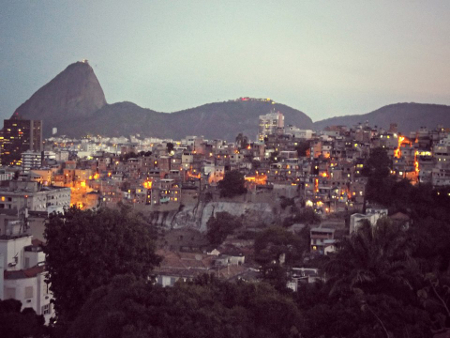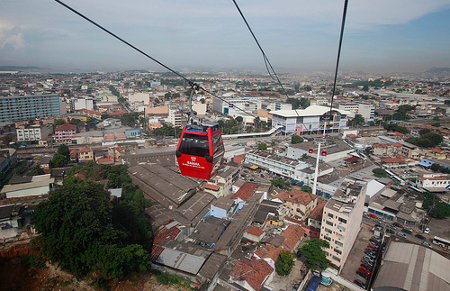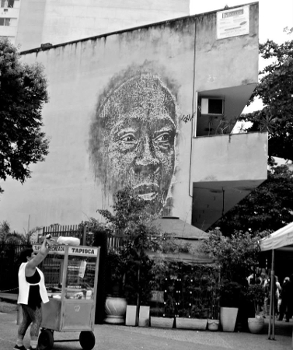

I investigate how Rio is transforming ahead of two sporting mega-events at the end of 2013, as part of the LSE USA Blog’s coverage of the North American neighbourhood.
Protests across Brazil have been reignited after complaints over metro fare hikes boiled over into the streets and Rio’s Central Station earlier this month. Chants proclaiming “FIFA pay my tarifa”, or metro fare, illustrate the still-brewing anger over perceived wasteful spending on stadia for the World Cup later this year and the 2016 Olympic Games, in place of better public services. Most recently, 15,000 people in the capital, Brasília, staged protests outside President’s Dilma Rousseff’s state office, which ended, as protests in Brazil so often do now, in a violent clash between police and rioters.
“There is a brutality to mega-events that we should be under no illusion about,” Dame Tessa Jowell, former UK Olympics Minister, told a group of city planners, policymakers and academics at the 2013 Urban Age Conference in Rio, which is organised by LSE Cities and the Alfred Herrhausen Society. I was at the conference looking at the impact of LSE research in Brazil for an LSE Review of Books podcast series. In the context of Brazil, the word “brutality” certainly takes on another meaning, but Jowell was alluding specifically to the temporality of sporting events which, if left unchallenged, will no doubt overshadow the permanence of their aftermath. She recalled the words of the London Olympic organising committee’s chief executive who said, in very terse terms, that after the Olympic closing ceremonies, “The circus will move to Rio. There’s no gradual fade-out, that’s it. London was 2012, Rio is 2016”.
With this in mind, Jowell argued the only way to minimise and perhaps even capitalise upon the “brutality” of these events, is to be clear about what bigger idea underpins them. In the case of the 2012 Olympic Games, she insists all actors were first and foremost committed to its legacy, particularly in London’s East End. There are early indications that this legacy has been met with some success and that direct positive impacts from London 2012 have already manifested, though the true long-term effects of the Olympic legacy won’t be fully known for decades. But as the relatively fleeting moment of hosting the two games looms heavily over Rio, questions have been raised about the planning philosophy that underpins how the city’s transformation is occurring, and the effects this will have on residents.

“We are using the great global events to catalyse urban transformation and to produce a more equal city,” Washington Farjado, special advisor to the Rio Mayor Eduardo Paes, told me when I asked about the role of the state in producing transformations. This oft-repeated sentiment from officials has been met with much scepticism in Rio. Jailson de Sousa e Silva, Director of the NGO the Observatório de Favelas cites the example of the costly construction projects in Complexo do Alemão which included a new cable car, to illustrate what he sees as the state’s main problem: community participation. He said, officials “Arrived with ready-made projects, presented it to the community, listened, and then ignored them. It is like if I arrived at your house and told you I would be doing several construction projects, but I never asked you what you needed. And then [only] after I finished everything, did I start listening to you. I can’t say that is participation and that’s how a lot of the construction projects were executed in those communities”.
The marvellous and divided city
The word ‘equality’ is highly disputed in Brazil, both in terms of what it actually means and how then to achieve it. Those in charge of seeing the mega-events through, claim ‘equality’ is their guiding principle, a means to benefit from the costly expenditures with which these games come. The dissenting voices find this to be an all too useful justification for the private developers that claim to have sought participation from local communities, but never went as far to gain their constructive input or explicit consent. These mega-events have unveiled for the world Rio’s ongoing struggle to reverse its deep-rooted spatial inequalities.
The city’s dramatic landscape of sloping hills alongside beautiful coastline, can inspire envy even in the most secure metropolitans, but this urban geography also tells a story of century-old segregation. Whereas most cities are usually known for epitomizing love, sin, windiness, or even more bizarrely, other cities (see: The Paris’s and Venice’s of places not in France nor Italy), Rio de Janeiro dons a conflicting set of nicknames: both “The Marvelous City” and “The Divided City” have characterised it in equal measure.
Nowhere is this contradiction in nomenclature more apparent than in the city’s southern zone where favelas perch on hilltops just above modern beach-front apartment blocks, home to the city’s wealthiest. Decreased life expectancy, drug-related violence, and limited access to services for favela residents, reinforces the class divide between those in the morro (hills) and those on the asfalto(asphalt).
These geographical barriers are becoming more porous, however. Part of this is due to the freedom of movement that increased safety brings. The street between two favelas that leads to the beaches below in Ipanema – Cantagalo and Pavão-Pavãozinho – was once a dangerous passageway where local drug factions routinely exchanged gunfire. Today, it is busy with residents strolling down its long stretch of concrete to reach Ipanema beach or to visit the Açaí-juice bars and shops along its path. While the bullet-holes are still visible here, the gangs are not. A programme of ‘pacification’ has seen police move into favelas and drive out drug lords (though some still operate underground in the favela, albeit less violently). As favela residents feel more comfortable going down to the asfalto, so do people in the asfalto about going up to the morro to party and even to live.
For a weekend in Rio, I stayed in Pavão-Pavãozinho, which is a lower middle-class community mostly comprised of migrants from the northeast of Brazil, in the rented flat of Jurema, a fashion designer. Jurema lived for nearly a decade on the asfalto, but then moved (geographically) upwards, to the favela above. “It’s not great,” she told me, “But it is a lot cheaper to be here where I don’t have to spend most of my salary on rent.” By “not great”, Jurema was unmistakably referencing the chaos around us: deafening music from the shop and bar next door, the open sewers, and her cleverly, but precariously built home reached only via an ascent of 400 wobbly stairs. In spite of all this, rent and house prices have risen so dramatically in the run-up to The World Cup and Olympics, that the favela is a viable alternative for Jurema and for many others looking to live more cheaply in the centre of the city.
This increased porosity between these two worlds can have its downsides. In a recent LSE Cities publication Savvas Verdis and Ricky Burdett ask whether or not city officials responsible for development can plan against all forms of inequality, “By eradicating one form of poverty do city transformations lead to new ones?”.
Brazil’s favelas, like most shantytowns, are characterised by their outsider status. Homes are built brick-by-brick by local, unlicensed tradesmen (they stack the bricks vertically rather than horizontally as this gives you more bang for your real, the Brazilian currency). Clusters of wires jump from house to house – luz do gato, or ‘gangsta wiring’ – giving illegally sourced electricity to hundreds or sometimes thousands of homes. This is all set to change as favelas become ‘urbanised’ by the state, or made a more formal part of the city, a goal set for completion by 2020. Indeed, the whole philosophy behind police pacification is the establishment of the state’s presence where there has long been an absence; primarily by headquartering in favelas and maintaining police presence around the clock. But as these communities gain upgrades like better sewage, electricity via the grid, paved streets, and increased security, there is also a risk that these upgrades could ultimately lead to their demise. “After pacification,” says writer Suketu Mehta to the audience at Urban Age, “The biggest threat to long-time residents of the Rio favelas will come not from drug dealers, but from property dealers.”
The general balance between short-term and long-term needs facing Rio, is playing out in all cities facing a dramatic and rapid transformation, but throughout these changes, what remains key to building a happy city, is flexibility. “Cities can’t be seen as works of art because works of art get finished,” said Director of London’s Design Museum, Deyan Sudjic, to the audience at Urban Age, referencing Haussman’s ambitious but ossifying redesign of Paris which has no doubt contributed to the city’s spatial inqualities. Transformations, therefore, must both simultaneously suit the needs of a space in time and allow flexibility for future uses. The problem with stadia is that they, like works of art, “get finished” and the role of mega-events as great equalisers is therefore limited.

Rio has passed legislation to mitigate the sometimes forceful hand of commercial development through its 2001 Statute of the City which guarantees precedence to the social use of land over private use. Yet, however guarded against land-sharking Brazil’s laws appear to be, there has been a tendency on the behalf of planners to homogenise the needs of areas like favelas, in order to justify the construction of lucrative private developments in the name of equality. If equality is the underpinning infrastructure of these World Cup and Olympic Games, it is clear those most affected by equality’s absence, struggle to influence the policies carried out in its name.
“It is a mistake to treat all favela dwellers like they are projects. It is the state that carries out a segregational logic,” Jailson de Sousa e Silva said at one panel session at the Urban Age conference, which sparked a passionate exchange of words between civic leaders and city officials. Edgar Pieterse, Professor and Director of the African Centre for Cities at the University of Cape Town, later commented, “I feel like a therapist listening to a family that is traumatised”. Others chimed in pointing out that at a conference designed for cities to learn from the experiences of other cities, how much his Rio actually learning from Rio and how much is Rio just talking across Rio? The answer to that question will come to define the aftermath of 2014 and 2016’s games.
Meanwhile, there are only a few months left until the first sporting circus moves through Brazil. With protests in Rio and across the country spreading and taking on new forms like the flash-mobs-esque rolezinhos in malls, or the more violent, European-style Black Blocs, the whole world finds it too is sitting in on Brazil’s family therapy session and one that shows no signs of abating.
The LSE Review of Books blog has launched a three-part podcast series on LSE’s research impact in Brazil. Cheryl traveled to Rio and São Paulo at the end of last year to speak to academics and policymakers in the country about research on topics ranging from favelas, city transformations, and leftist politics.